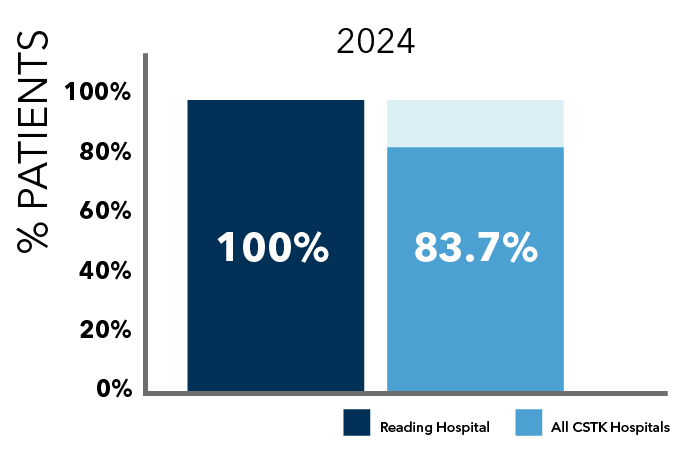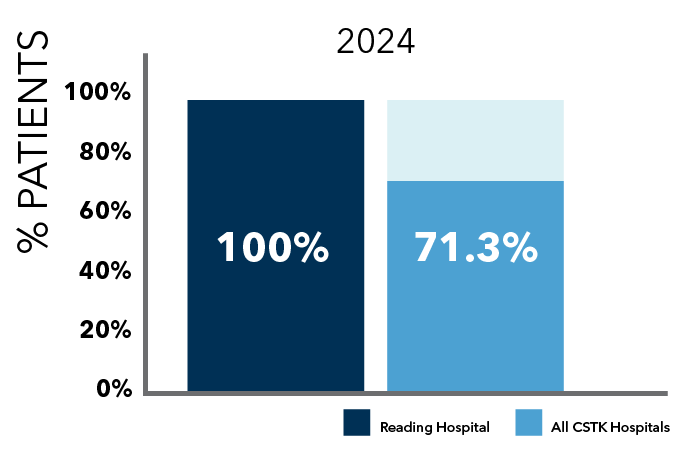The Stats Behind Stroke
Stroke kills more than 128,000 people each year and is a leading cause of serious, long-term disability. The outcome often depends on how and when a patient is treated.
Reading Hospital, our flagship Comprehensive Stroke Center, has long been recognized for excellence in stroke care. Our high-volume program treats more than 1,000 strokes per year, and achieves clinical outcomes in the top 5% nationally. It has been recognized by Healthgrades as one of America’s Top 100 Hospitals™ for stroke.
Here is how Reading Hospital compares to other comprehensive ("Level 1") stroke centers:
Clot Busting Medication
Measure Summary
Target Stroke Measures
- AHASTR49: Time to intravenous Thrombolytic Therapy - 45 minutes
- Percent of acute ischemic stroke patients receiving intravenous thrombolytic therapy during the hospital stay who have a time from hospital arrival to initiation of thrombolytic therapy administration (door-to-needle time) of 45 minutes or less
- Time Period: 2024 January - 2024
- Site: Reading Hospital and Medical Center (21284)

- Image description
Overview
This chart shows the proportion of patients who achieve a “door-to-needle” time in less than 45 minutes. “Door-to-needle” time is the amount of time it takes to administer clot-busting medication to a patient from the moment they arrive in the emergency department. The national guideline is to achieve this within 45 minutes. Reading Hospital is compared to other comprehensive stroke centers.
Values
Numerical values presented on the image:
2024 Reading Hospital 100% All Comprehensive Stroke Hospitals 83.7% Presentation
The bar chart represents the percent of acute ischemic stroke patients receiving intravenous thrombolytic therapy during the hospital stay who have a time from hospital arrival to initiation of thrombolytic therapy administration (door-to-needle time) of 45 minutes or less in 2024.
Clot Removal Procedure
Measure Summary
Endovascular Therapy (EVT) Measures
- AHASTR112: Door to Recanalization/Reperfusion (DTRp) within 120 minutes
- Percent of patients with acute ischemic stroke who receive mechanical endovascular reperfusion therapy and for whom the time from hospital arrival to recanalization/reperfusion with TICI grade 2b or 3 is <= 120 minutes
- Time Period: 2024 January - 2024
- Site: Reading Hospital and Medical Center (21284)

- Image description
Overview
This chart shows the proportion of patients who achieve a “door-to-reperfusion” time in less than 120 minutes. “Door-to-reperfusion” time is the amount of time it takes to remove a blood clot from the moment a stroke patient arrives in the emergency department. This is done with an endovascular procedure called a mechanical thrombectomy. The national guideline is to achieve this within 120 minutes. Reading Hospital is compared to other comprehensive stroke centers.
Values
Numerical values presented on the image:
2024 Reading Hospital 100% All Comprehensive Stroke Hospitals 71.3% Presentation
The bar chart represents the percent of patients with acute ischemic stroke who receive mechanical endovascular reperfusion therapy and for whom the time from hospital arrival to recanalization/reperfusion with TICI grade 2b or 3 is <= 120 minutes in 2024.
